The Ten Most Dated Superheroes (That Are Actually Still Around)
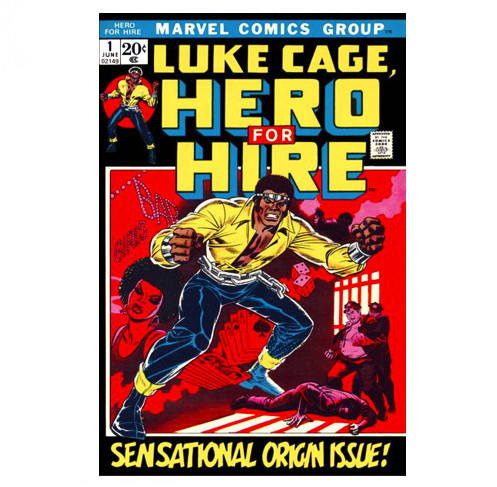 |
Mainstream comics have always chased fads in popular culture, from music to fashion to just about everything else in between, always seeking to find a way to stay relevant in a world where something is cool one minute and yesterday’s news the next. Here are ten example of times when the big comic companies shamelessly pursued fads in the mainstream of the moment, only to have the characters outlive the fads, sometimes by decades.
10. Luke Cage
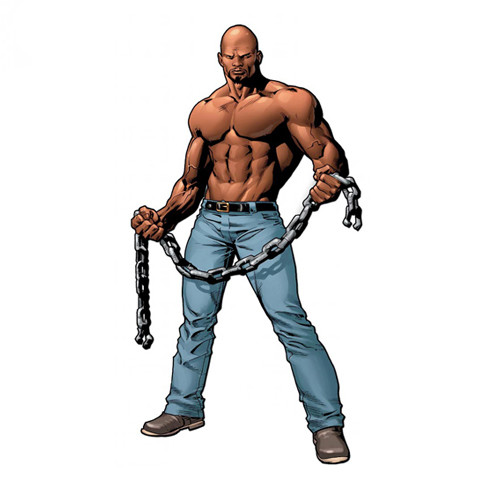 |
In the early seventies, the Blaxploitation boom had begun in American cinema in earnest, starting with movies like Shaft, Superfly, Coffy and countless others. Although these movies were all intended for an urban African-American audience, the truth is they found a very large following with just about everyone else too. Marvel Comics, never ones to pass on any pop-culture fad, wanted in on a little of that Blaxploitation action, and in 1972 they unleashed Luke Cage, Hero for Hire on the comic buying audience.
In that first issue, a young “jive talkin’ man named Carl Lucas is sent to prison for a crime he didn’t commit, and in exchange for parole, he undergoes an experimental procedure, supposedly meant to cure diseases or something. Instead, it inadvertently gave him steel-hard skin and enhanced muscles. After escaping prison, he forged the identity of “Luke Cage,” becoming a super-powered private detective, whoopin’ all kinds of bad guy ass up in the hood. A bona fide super hero now, Cage’s costume was a yellow blouse, blue tights, and a silver tiara. Somehow, I couldn’t see Richard Roundtree working that look. In fact, I can’t think of a heterosexual black man outside of maybe Prince who would even dare to make the attempt.
The book was filled with cliches, especially all the “jive talk” and catchphrases that Cage would spout out, most famously “Sweet Christmas!” (in case there was any doubt, Luke Cage was totally created by white people.) Eventually, Luke Cage would take on a proper super hero name (Power Man) and team up with another character created to cash in on a seventies trend, the martial artist Iron Fist. The Blaxploitation craze died out with the end of the seventies, but Luke Cage continued on, partnered with Iron Fist, until 1986. From that time on, he appeared sporadically in the Marvel Universe and inspired the stage surname of a certain insane actor named Nicolas, although in the last few years Luke has risen to prominence again in the pages of Avengers. The yellow blouse and tiara are long gone though, which if ya ask me, is a damn shame.
9. Blade
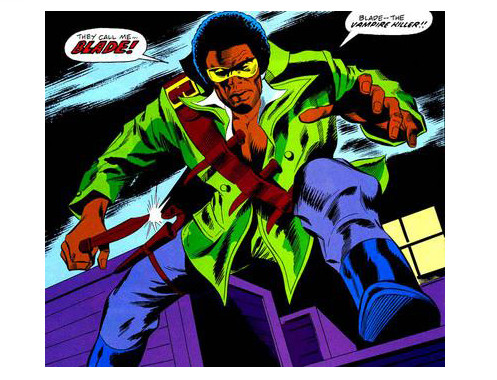 |
Luke Cage wasn’t the only Marvel character created to take advantage of the Blaxploitation phenomenon; vampire hunter Blade – a half human, half vampire hybrid -was created as an adversary for Dracula himself in the pages of Tomb of Dracula. Created by writer Marv Wolfman and artist Gene Colan, Blade was visually based on NFL star Jim Brown, as much as any particular Blaxploitation star. Blade proved very popular with the readership, and by the end of 1973 was the cover feature on Marvel Preview magazine. During this time he also fought Morbius, the Living Vampire and appeared in other Marvel horror comics. Tomb of Dracula was cancelled in the late seventies, and after that Blade made only sporadic appearances.
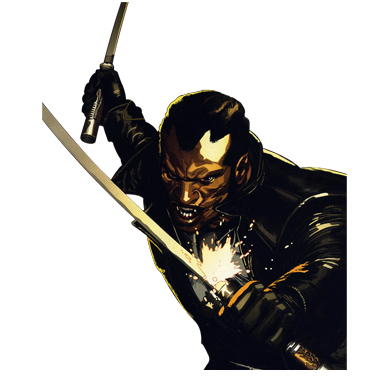 |
Blade’s true claim to fame, of course, is in the 1998 movie staring Wesley Snipes. This was the first successful Marvel film, which ironically was based on a character that even many hardcore comic book fans were unaware existed at the time. Of course, with his return to prominence in the movies, Marvel had to give him a more prominent place in the comics as well, and he’s had various series and mini-series dedicated to him ever since Hollywood discovered that he was a valued commodity. Last seen regularly in the pages of X-Men, Blade is now too valuable a character to sit on the shelf at Marvel for too long. Considering his was the first big-screen Marvel success story, every Marvel character from Spidey to the Avengers owes their big screen life to a character who started out as not much more than yet another attempt to cash in on a pop culture craze.
8. Vibe
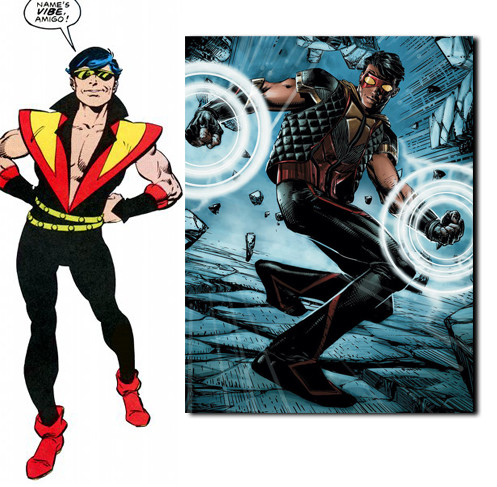 |
Has there ever been a character in DC Comics’ history more endlessly mocked than mid-’80s Latino break-dancer Vibe? How did such a cheesy, stereotypical character ever even come to be? Back in 1984, DC decided to revamp the Justice League of America. Sales on JLA were falling hard, and the once premiere super-team were now being outsold by their former sidekicks, the Teen Titans. Apparently in looking for ideas for the new Leaguers, DC decided to look towards popular culture for inspiration.
Superman, Batman, Wonder Woman and other JLA icons were removed, and in their place were all new characters, all seemingly based on pop-culture fads of the moment. There was Gypsy (who turned invisible) who looked like a cross between Cyndi Lauper and early Madonna; Vixen, an African American femme fatale who looked a lot like Tina Turner; Steel (an athlete turned cyborg) was the living embodiment of Olympic fever (1984 was the year that Los Angeles hosted the Olympic Games, and Olympics mania was everywhere.)
And then finally there was Paco Ramone, better known as Vibe. A Puerto Rican breakdancer who could created seismic tremors. Paco spoke in horrible “watchu doin’ mang?” style English, wore yellow parachute pants, was a gang member, and most famously, break danced while using his powers. In the early to mid ’80’s, breakdancing was all over the media, from Saturday morning cartoons to movies like Breakin’ and Krush Groove. Somewhere, Superman was giving a giant facepalm at this lame attempt from the powers that be at DC to try and be hip. In fact, the character of Vibe was such an offensive stereotype that DC’s superstar artist of the era, Puerto Rican George Perez, swore off drawing the JLA’s book during this era.
This team was so tied into pop-culture fads, that a mere two years after they were created, most of the new members were already looking dated as hell. This version of the JLA was ultimately deemed a sales failure, and Vibe was killed off in DC’s Legends crossover event. The very first Latin-American character ever to make it to the League would also be the first member of the League to die in the line of duty. After that, aside from the occasional mention, Paco was swept under the rug, as DC’s biggest politically incorrect embarrassment.
Leave it to Geoff Johns, DC superstar writer and lover of all things retro in comics, to revive Paco for the New 52. Not only is he back, but he actually has his own ongoing monthly title, something that would have been unheard of back in the day. The new version of Vibe has the same powers, but has left behind the breakdancing and the cheesy accent, and seems like an honorable attempt at doing the League’s first Latino member some kind of justice. Much in the same way that the original Batwoman was created as a reaction to cultural homophobia, and then later made a lesbian as a statement against it, hopefully Vibe 2.0 can make up for the racist caricature of the past.
7. Power Girl
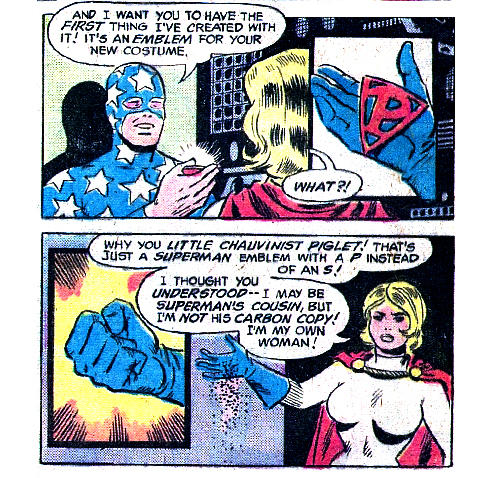 |
This one might be a wee bit of a stretch, but just go with me here. In my opinion, DC Comics’ Power Girl was absolutely a cash-in on the mid 70’s fad of “Feminist Chic” that was going on in pop culture at the time, especially on American television screens. Now, to be clear, I’m not suggesting that the concept of feminism is a mere fad, but during the mid-to-late 70’s, there was a brief time when the concept of women’s lib was being exploited by the media as something of a trend. As a facet of this trend, there were strong women starring in leading roles in action/adventure shows for the first time ever. Police Woman was a popular show starring Angie Dickinson, and was the first ever hour-long action show starring a woman. It ran for four years and 92 episodes. This of course was followed up by Charlie’s Angels, The Bionic Woman and of course Wonder Woman starring Lynda Carter. But Police Woman was the trend-setter, and you can see that in Power Girl’s first appearance, where she is a dead-ringer for Dickinson.
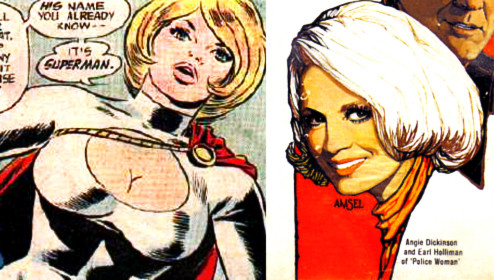 |
When Power Girl was originally introduced back in 1976 in the pages of All-Star Comics, she was essentially a “Women’s Lib” version of Supergirl; she was still Superman’s cousin and her real name was Kara, just like Supergirl, but this was the Superman of the parallel Earth-2. But this was a ’70s version of Supergirl, with all the baggage of the era in tow. My first exposure to the character was in an issue of All Star Comics, where her fellow teammate the Star Spangled Kid decided to reward Kara with a symbol similar to her cousin Superman’s, a letter “P” in a triangle. An enraged Power Girl crushed it, yelling “I’m not some cheap carbon copy!” From that moment forward, I always preferred Power Girl just a li’l bit more than Supergirl. Everything about that era of Power Girl was obviously some older straight dude’s idea of what feminism was, through the filter of the media (“They’re angry! But still sexy!”) and eventually, Power Girl became a fully rounded character. (uh, no pun intended.) She continues to be a mainstay of the DC Universe to this day, long after the fad of powerful action hero women on television has passed. A fad that sadly, should have never really ended.
6. Grunge
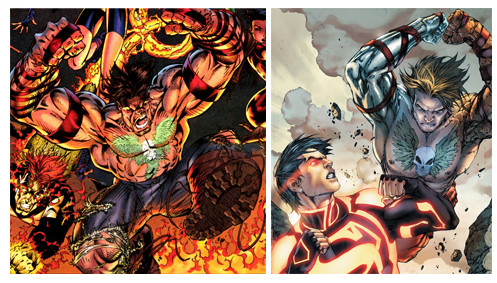 |
As much as Marvel and DC gave into stealing from pop culture fads at large when creating new characters, it is possible no one fell into this trap more than the characters created in the formative years of Image Comics,back in the early 1990’s. Not only is the character Grunge, created by Jim Lee and J. Scott Campbell for Wildstorm comics series Gen 13, based on a music fad, this character is unimaginatively even named for said fad. (Can you imagine if Dazzler had just been named “Disco?”)
Percival Edmund Chang, as he was really called, was like a smorgasbord of ’90s pop culture cliches all mixed into one character; he’s slacker, a term popularized at the time, but he’s also named for a music scene that started in Seattle and spread like wildfire through pop culture during this period. So of course, the character Grunge is also from Seattle. It was like every early ’90s Generation X cliche rolled into one. Ripped jeans, Doc Martens, tats across the chest, you name it, Grunge left no ’90s cliche unused. Aside from being from Seattle, the only reason the character is even called Grunge is that he got to choose his own hero name; his power is to molecularly bond with and take on the properties of any object he touches. Really, what’s so “Grungy” about that?
The funny thing is, by the time the character Grunge made his comic book debut in 1994, the grunge rock phenomenon, which began to hit the mainstream in earnest in 1991 with the release of Nirvana’s album Nevermind and the subsequent success of bands like Pearl Jam, Alice In Chains and Soundgarden had already become played out. Much of the music would continue to find success, but the term “grunge” was more or less dropped, making the Wildstorm character seem even more out-of-date.
Somehow though, the character has survived, and has shown up in not only all subsequent revivals of Gen 13, but is even in the New 52, as an adversary for Superboy. At least it looks like this version of ol’ Grungey boy appears to have layed off the steroids a bit.
5. Shang-Chi, Master of Kung Fu
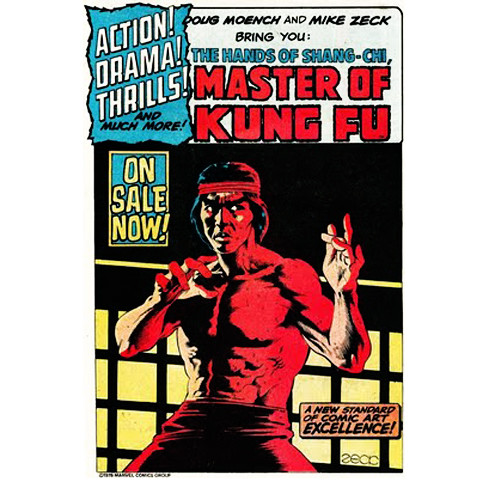 |
Beginning with the premiere of the television show Kung Fu in 1972, then followed up that same year with Bruce Lee’s Fists of Fury and Enter the Dragon (and of course, Carl Douglas’ hit disco song “Kung Fu Fighting”) America was in the midst of a martial arts craze in the early seventies. Marvel Comics, again clearly never ones to not try and cash in on a fad, decided to create their own martial arts hero. Now here’s the weird part; Marvel actually secured the rights to ABC’s Kung Fu series, as well as the character of Fu Manchu from the pulp novels of writer Sax Rohmer. Instead of adapting either directly, creators Steve Englehart and Jim Starlin created a new character named Shang-Chi, Master of Kung Fu, which incorporated elements of both.
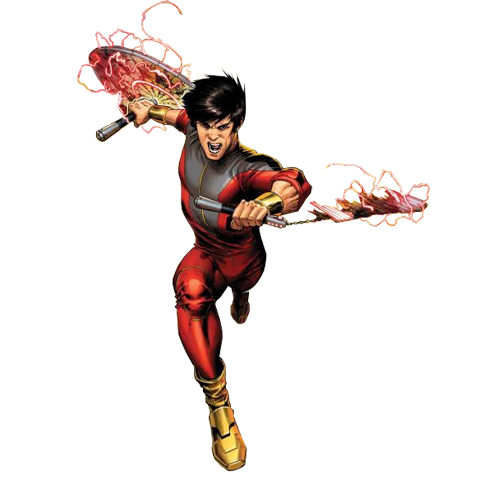 |
Shang-Chi was the son of Fu Manchu, who fought against his father’s villainous ways. Marvel also used elements of the television show, but changed enough to make it their own. By buying the rights they just made sure that the ABC Network couldn’t sue them for any similarity, but this way they weren’t beholden to the the continuity of the series either. This might seem like a crazy move today, to secure the rights to a character or show and then not use them, but it turned out for Marvel it was a brilliant move to do so. The show Kung Fu ended in 1975, and the comic Master of Kung Fu ran well past that, lasting well into the eighties and over 125 issues. Shang-Chi outlived the martial arts fad of the seventies, and it should be noted, that while the show Kung Fu used a white actor in an Asian part, Marvel proudly drew their character as Chinese, the first Asian hero to headline his own Western comic book. Shang-Chi survived the odds, and is currently a member of Jonathan Hickman’s Avengers series.
4. Teenage Mutant Ninja Turtles
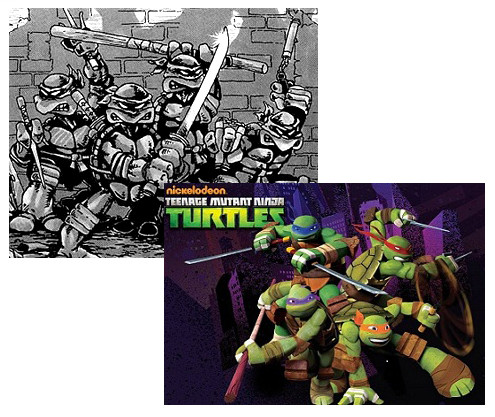 |
One of the biggest success stories of comic book characters crossing over into mainstream success ever, the Teenage Mutant Ninja Turtles began more or less as a joke, as a means for indie creators Kevin Eastman and Peter Laird of parodying some of the biggest comic book fads of the eighties. Back in 1984 when Ninja Turtles were first published, the biggest selling comics were DC’s The New Teen Titans (hence the teenage), X-Men (hence the mutants) and Frank Miller’s work on Daredevil, Elektra and Ronin, all of which heavily featured ninja themes. The original Ninja Turtles comics were in black and white, and a huge success with the comic geek crowd. But they were about to branch out to a whole new demographic, big time.
It was in the late ’80s that the Turtles really took off in the mainstream, when their cartoon hit the airwaves and their action figures began to hit Walmart shelves. Years before any of the fads they were mocking like X-Men or Teen Titans made it onto the airwaves or on movie screens, Ninja Turtles became household names first. TMNT started their own wave of imitators (anyone remember Biker Mice From Mars? Wild West C.O.W.-Boys of Moo Mesa?) But none could match the Turtles’ sway over the kids of America, a sway that continues to this very day, with a new show on Nickelodeon and a big budget remake of the property coming soon. Eastman and Laird took their little parody of comic book fads of the time and laughed their asses all the way to the bank.
3. The Sandman
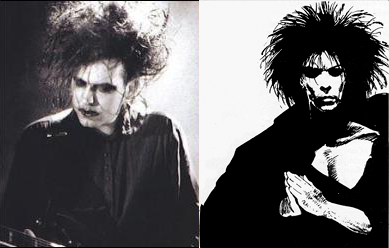 |
On a storytelling level, Neil Gaiman’s brilliant fantasy opus The Sandman, which ran for 75 issues for DC Comics and won all kinds of literary accolades, isn’t really based on any one fad. On a visual level though? Try and tell me that Morpheus the Dream King, the main protagonist for the Sandman series, isn’t based on The Cure frontman Robert Smith. The hair, the eye make-up, it’s all right there and in yer face. Dream’s sister Death could also be Siouxsie Sioux from Siouxsie and the Banshees, or really any goth girl from the late ’80s or early ’90s.
The visual look of Dream’s family, better known as the Endless, has got to be based on these goth music icons; I don’t care what anyone says on the record. In fact, original Sandman artist Sam Kieth probably made a conscious effort to have based the look of the Endless on the then thriving gothic rock movement. Although the characters could have looked like anyone, truth be told, their visual resemblance to goth icons only helped sell the Sandman series to a whole new market of readers; in the ’90s, it was nearly impossible to meet a goth kid who didn’t revere Gaiman’s Sandman series. And I’m sure there are some baby goths discovering Sandman for the very first time even today, just due to visual gothness of it all and the fact that Dream looks like Robert Smith. Okay, and Edward Scissorhands too.
2. Shazam! / Captain Marvel
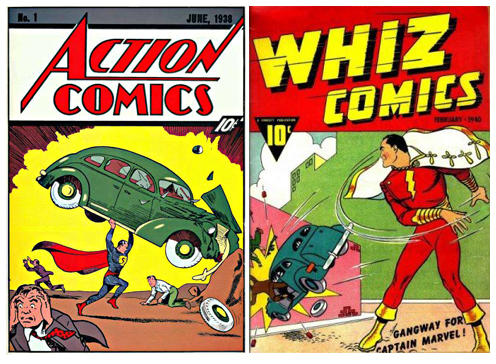 |
When Superman debuted in 1938, he was the kind of overnight success seen once in a generation. Within two years of his comic book introduction, Superman had a float in the Macy’s Thanksgiving Day Parade, a movie serial on theater screens, a radio show and several merchandising tie-ins. There wasn’t a person young or old in America who didn’t know who Superman was. He was the first comic book superstar, and it is fair to say that every super hero created since is a bit of a cash-in on the sensation that was Superman. But no character was as much of a blatant attempt to take advantage of the Superman fad than Fawcett Publication’s Captain Marvel, now commonly referred to as Shazam, after the magic word that gives the character his powers.
Originally published in 1939, Captain Marvel was one of dozens of super-hero characters created in the wake of the success of Superman. But none of those characters were as similar to Supes as Captain Marvel was; Marvel had the same powers as Superman, his alter-ego was also a reporter, and he had the same overall look (although with a different color scheme) and the cover of Marvel’s first appearance had him tossing what seemed like the same green car that Superman was throwing around on the cover of Action Comics #1. There were as many differences as similarities to Superman to be honest, but to National Comics, all they saw were the similarities….that, and the fact that the character was actually outselling Superman for awhile drove the folks at National crazy. They sued Fawcett for copyright infringement, and spent the better part of the next decade in court, until 1953, when after twelve years in litigation, Fawcett caved and settled, paying $400,000 in damages and promising to cease publishing all Captain Marvel titles, which had been dwindling in sales anyway by the ’50s.
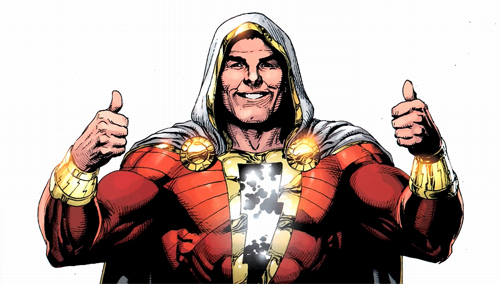 |
The big irony of course is that in the ’70s, DC Comics actually bought the character of Captain Marvel, a character they spent over a dozen years trying to destroy. He never regained his original popularity ever again, but even now DC is attempting another revival of the concept, this time calling him only Shazam, named after the wizard who gave Marvel his powers. One can hardly blame DC for not wanting to use the word Marvel on one of the characters anyway. Whether or not Shazam is a character that can survive in the modern comic book world remains to be seen, but you can’t blame DC for trying. One thing is certain, Shazam has long since outgrown his status as simply the knock-off Superman.
1. Dazzler
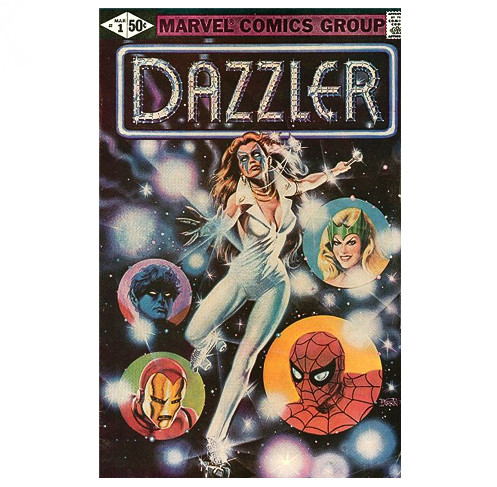 |
Could any other character have taken the top spot? Dazzler is the epitome of a comic book company looking for a way to crassly take advantage of a pop-culture sensation, and bungling it every step of the way. Yet the character survives to this day, against the odds. In this instance, the pop culture fad was disco. Dazzler was created by Marvel in the late ’70s in what had to be one of the most bizarre attempts at corporate cross promotion in comics history. Dazzler was intended to be a multimedia co-creation between Marvel Comics and several partners; disco label Casablanca records would “create” a singer they would name Dazzler, then a movie studio would get a star to play her in a film (the front runner was said to be model/actress Bo Derek) and finally Marvel would chronicle the character’s comic book adventures.
By 1980 however, the “Disco Sucks” backlash had started in America, and just as fast as it became the biggest thing since sliced bread, disco was dead and buried, and everyone but Marvel had pulled out of the project, leaving Marvel with a new super hero to promote based on a dead fad. Nobody but Marvel had come through with their part of the deal, there was no singer, no star, but Marvel was determined. Dazzler finally made her debut in Uncanny X-Men, as mutant disco singer Allison Blaire. Dazzler rocked a shiny silver one-piece jumpsuit with a flared collar, mirrored roller skates, and an actual disco ball hanging around her neck as a necklace. Her powers were the ability to turn sound into light, which could result in glittery nightclub shows, or deadly laser beams. Marvel quickly spun-off Dazzler into her own comic, but despite selling 400,000 copies of her first issue (a huge amount by today’s standards) Dazzler’s series was cancelled by the mid ’80s.
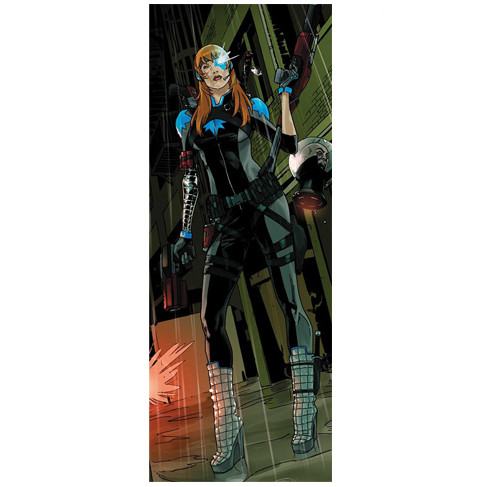 |
But someone up there likes Dazz; after her series was cancelled, she was folded into the X-Men, Marvel’s premiere super team. Not bad for a character who was created as nothing but a gimmick. She’s been an X-Man on and off for years ever since, most recently the book X-Treme X-Men. The one piece jumpsuit may be long gone, but a little of the old Dazzler remains. I mean, check out those disco ball boots she’s been wearing lately. They’re fierce.

